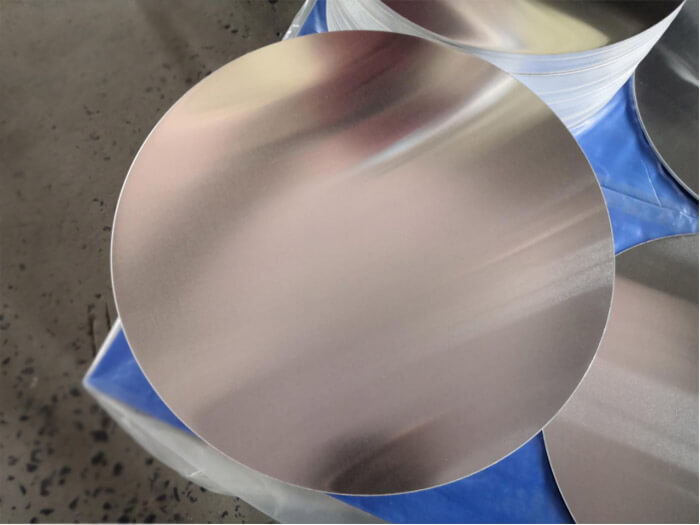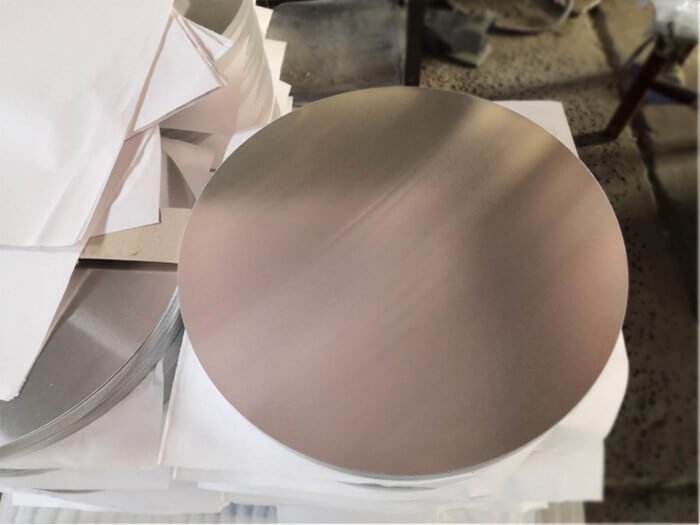Aluminum has long been a favored material in cookware manufacturing due to its excellent properties, such as lightweight, phahameng mocheso conductivity, le khanyetso ea kutu. Among various aluminum products, the Aluminium circle disc stands out as the preferred choice for making cookware. This blog post explores the reasons why Aluminium circle disc s are ideal for cookware manufacturing, supported by detailed comparisons and key advantages.

One of the primary reasons Aluminium circle disc s are ideal for cookware is their excellent thermal conductivity. Aluminum is known to conduct heat more efficiently than many other metals, such as stainless steel and cast iron. This ensures that the cookware heats evenly and quickly, making it easier to cook food uniformly.
Thermal Conductivity Comparison of Common Cookware Materials
| Lintho tse bonahalang | Thermal Conductivity (W/m·K) | Heating Efficiency | Heat Distribution |
| Aluminium | 237 | Phahameng | Even |
| Ts'epe e sa beng le mabali | 16 | Tlase | Uneven |
| Tšepe ea ho Lahlela | 80 | Mahareng | E itekanetseng |
| Koporo | 401 | Holimo Haholo | Very Even |
As shown in Table 1, aluminum offers a good balance between cost and performance, making it the preferred choice for cookware.
Another significant advantage of using Aluminium circle disc s in cookware manufacturing is their lightweight nature. Aluminum weighs approximately one-third of what stainless steel does, making it easier to handle during cooking. This is especially important for cookware items like frying pans, lipitsa, and griddles that need to be lifted or maneuvered frequently.
Weight Comparison of Common Cookware Materials
| Lintho tse bonahalang | Botenya (g/cm³) | Relative Weight in Cookware |
| Aluminium | 2.7 | E bobebe |
| Ts'epe e sa beng le mabali | 8.0 | E boima |
| Tšepe ea ho Lahlela | 7.2 | Very Heavy |
| Koporo | 8.96 | E boima |
The lightweight nature of Aluminium circle disc s ensures that cookware is easy to handle and reduces fatigue during cooking, making them popular among both professional chefs and home cooks.
Aluminium circle disc s are cost-effective compared to other materials used in cookware manufacturing. While materials like copper and stainless steel offer certain benefits, their high cost often makes them less accessible to the average consumer. Aluminium, ka hlakoreng le leng, is abundantly available and less expensive, making it an economical choice for mass production of cookware.
Cost Comparison of Cookware Materials
| Lintho tse bonahalang | Relative Cost | Manufacturing Cost | Market Accessibility |
| Aluminium | Tlase | Tlase | Phahameng |
| Ts'epe e sa beng le mabali | Mahareng | Mahareng | Mahareng |
| Tšepe ea ho Lahlela | Tlase | Phahameng | Mahareng |
| Koporo | Phahameng | Phahameng | Tlase |
As shown in Table 3, aluminum offers a cost-effective solution for both manufacturers and consumers without compromising on quality.
Aluminum naturally forms a protective oxide layer on its surface, which helps prevent corrosion. This property is particularly beneficial for cookware, as it extends the lifespan of the products and reduces the need for frequent replacements. While stainless steel is also corrosion-resistant, it comes at a higher cost, making Aluminium circle disc s a more economical option.
Corrosion Resistance of Cookware Materials
| Lintho tse bonahalang | Khanyetso ea Corrosion | Maintenance Required | Bophelo bo bolelele |
| Aluminium | Phahameng | Tlase | Long |
| Ts'epe e sa beng le mabali | Holimo Haholo | Tlase | Very Long |
| Tšepe ea ho Lahlela | Tlase | Phahameng | E itekanetseng |
| Koporo | Mahareng | Mahareng | E itekanetseng |
Aluminum’s excellent corrosion resistance makes it a practical choice for cookware that is used frequently and exposed to moisture and heat.

Aluminium selikalikoe disc s are highly versatile in terms of design and manufacturing. They can be easily formed into various shapes and sizes, accommodating different types of cookware, from frying pans and saucepans to woks and roasters. This flexibility in design allows manufacturers to cater to a wide range of customer preferences.
Versatility of Aluminium circle disc s in Cookware Manufacturing
| Cookware Type | Aluminium circle disc Suitability | Forming Ease | Customization Potential |
| Frying Pans | E kgabane | Easy | Phahameng |
| Saucepans | E kgabane | Easy | Phahameng |
| Woks | E ntle | E itekanetseng | Mahareng |
| Roasters | E kgabane | Easy | Phahameng |
| Griddles | E kgabane | Easy | Phahameng |
The ease with which Aluminium circle disc s can be manipulated into different shapes without losing their structural integrity makes them ideal for mass production and customization in cookware manufacturing.
Aluminium circle disc s can be polished to achieve an excellent surface finish, giving the cookware a sleek and appealing look. They can also be anodized or coated with non-stick surfaces to enhance both functionality and aesthetics. This adds to the overall appeal of aluminum cookware, making it attractive to consumers.
Surface Finish Options for Aluminium circle disc s in Cookware
| Phekolo ea Bokaholimo | Melemo | Boipiletso ba Aesthetic | Durability Enhancement |
| Ho benya | Smooth finish, easy cleaning | Phahameng | E itekanetseng |
| Anodizing | Khanyetso ea kutu, color options | Phahameng | Phahameng |
| Ho roala ho se nang thupa | Easy cooking, easy cleaning | E itekanetseng | E itekanetseng |
The ability to apply various surface treatments to Aluminium circle disc s further enhances their appeal in the cookware market.
Aluminum is one of the most recyclable materials available. This makes Aluminium circle disc s an environmentally friendly choice for cookware manufacturing. Recycling aluminum requires only 5% of the energy needed to produce new aluminum from raw materials, reducing the environmental impact of production.
Environmental Impact of Cookware Materials
| Lintho tse bonahalang | Recyclability | Energy Consumption in Recycling | Tšusumetso ea Tikoloho |
| Aluminium | Holimo Haholo | Tlase | Tlase |
| Ts'epe e sa beng le mabali | Phahameng | Mahareng | Mahareng |
| Tšepe ea ho Lahlela | E itekanetseng | Phahameng | Phahameng |
| Koporo | Phahameng | Phahameng | Mahareng |
The high recyclability of aluminum, combined with its low energy consumption during recycling, makes it a sustainable choice for the environmentally conscious consumer.

Aluminum cookware is safe for cooking when used with proper anodizing or coating to prevent aluminum from reacting with acidic foods. Anodized aluminum forms a non-reactive layer that prevents the leaching of aluminum into food, ensuring that the cookware is safe for long-term use.
Safety Features of Aluminium circle disc s in Cookware
| Sebopeho | Molemo | Health Impact |
| Anodizing | Non-reactive surface, no leaching | Safe for all foods |
| Ho roala ho se nang thupa | Reduced need for cooking oil | Healthier cooking |
| Even Heat Distribution | Prevents burning, consistent cooking | Better food quality |
By ensuring that aluminum cookware is properly treated, manufacturers can provide safe and reliable products that meet health standards.
Copyright © Huasheng Aluminium 2023. Litokelo tsohle li sirelelitsoe.